This Post May Contain Affiliate Links. Please Read Our Disclosure Policy.
When you’re wanting a super juicy, tender chicken breast, this sous vide method just can’t be beat. Sous vide is an easy, foolproof slow-cooking method that gives you perfectly moist boneless, skinless chicken breasts every time. Seasoned any way you like, this recipe for never-tough, never-dry chicken will be your go-to for holidays, large gatherings, or any time at all.
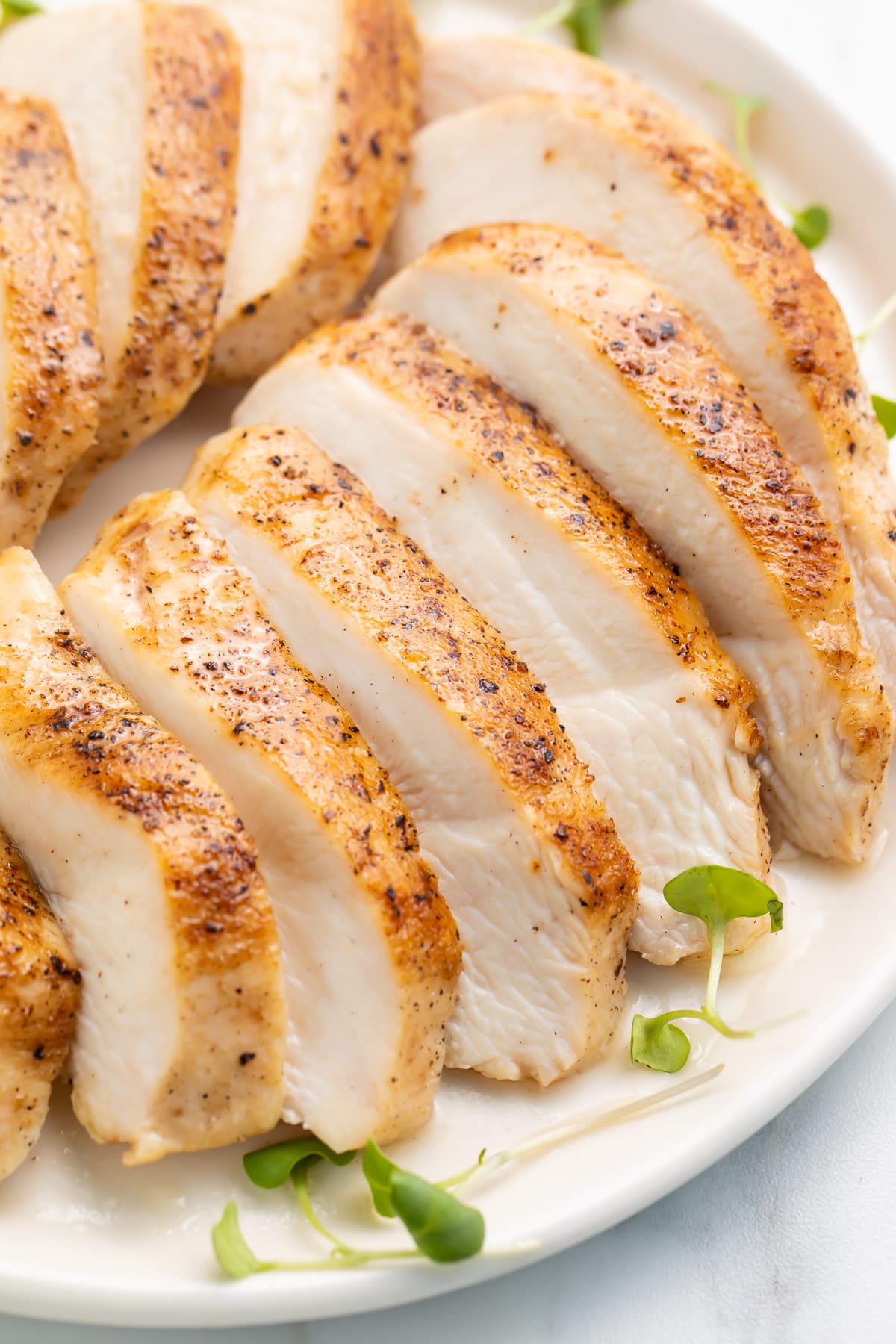
What is “Sous Vide”?
Sous vide, meaning “under vacuum” in French, is a method where food is precision-cooked in a vacuum-sealed pouch that’s submerged in a heat-regulated water bath.
The water bath keeps the food (in this case, chicken breasts) at a consistent temperature for longer periods of time than other cooking methods. This ensures the food is cooked evenly all the way through to the center, without the risk of overcooking the outer edges at the same time.
Before You Get Started
- It’s absolutely crucial that the chicken breasts are fully submerged in the water bath for the entire cook time. If they’re not completely submerged, they won’t cook evenly, so you might end up with undercooked sections or spots that are tough or dry.
How to Make This Recipe
See recipe card below for full list of measurements, ingredients, and instructions.
Prep the chicken.
Season 2 chicken breasts however you’d like, then put them in a large sealable food bag. Remove all the air from the bag, ideally with a vacuum sealer, and seal the bag completely. Place the bag of chicken in the preheated sous vide water bath and make sure the chicken breasts are totally underwater.
Cheryl’s Tip: If your chicken breasts just will NOT stay underwater, you can weigh them down by adding pie weights to the bag, taping silverware to the outside of the bag, or by using sous vide weights specifically for this purpose.
Enjoy your hour.
The sous vide’s got it from here! Let the chicken breasts cook in the water bath for an hour.
Sear the chicken.
After the chicken’s cooked for an hour, melt butter in a large skillet over medium-high heat. Take the cooked chicken breasts out of the water bath and bag, then pat them dry with paper towels and place them in the hot skillet. Sear the chicken breasts on both sides until they’re browned, then serve them however you like!
Cheryl’s Tip: If you plan to use the chicken breasts in another recipe, like a shredded chicken salad or chicken tacos, you don’t have to sear them after sous viding them. If you’re serving the chicken as-is, though, with just a side or two, I definitely recommend searing it first. There’s no browning or caramelization (a.k.a. the Maillard reaction) with the sous vide process.
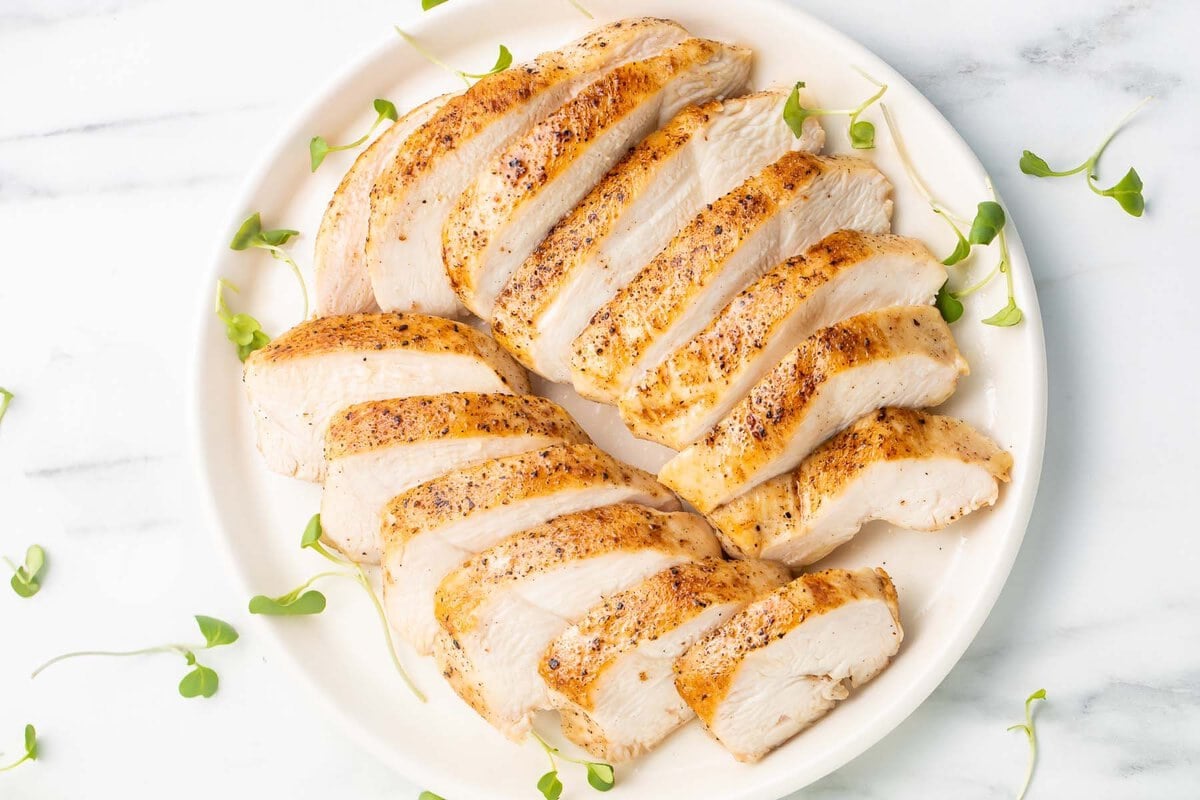
What I Love About This Recipe
- I. Love. Sous vide cooking. The method is just so easy – and SO foolproof. Drop the food in a water bath, come back later to perfectly cooked proteins or sides. It’s pretty much impossible to mess up. It’s also pretty much impossible to overcook the chicken breast this way, which can’t always be said for other methods.
- Another really great thing about a sous vide chicken breast recipe is that it’s super versatile. I used a simple salt-and-pepper seasoning with olive oil, garlic, and an infusion of fresh herbs, but you can season your chicken literally any way you like it. BBQ, garlic herb butter, lemon pepper, Cajun seasoning… anything goes!
- The sous vide method works for a frozen chicken breast, too. Trust me, you’ll be thrilled to have this option when you suddenly realize you forgot to defrost the chicken for dinner tonight. Just follow the recipe instructions as they’re written below, but add at least 30 minutes to the initial cook time. That gives the chicken extra time to thaw and then cook completely.
Is Chicken Cooked at 146.5°F Safe to Eat?
Yes! While the general food-safe temperature for chicken breast is 165° Fahrenheit, that’s actually an oversimplified standard.
What really matters is that pasteurization occurs, killing the salmonella bacteria – and that process depends on both temperature AND time.
165°F is the general guideline because at that temperature, pasteurization occurs instantly. Hit that number and boom, no more salmonella.
At 145°F, pasteurization takes around 9-10 minutes. That means the chicken has to reach 145°F all the way through and then be kept at that temperature for about 10 minutes.
It takes a little while for the chicken breasts to reach 145°F, though, which is why this recipe has a minimum 1-hour cook time.
Recipe Variations
- Chimichurri Chicken: Instead of fresh herbs, use the chimichurri sauce from our sous vide flank steak recipe.
- Garlic Lemon Chicken: Before adding it to the bag, rub the chicken with generous amounts of this simple lemon pepper butter or this incredible garlic herb butter.
- Cajun Chicken: Try a store-bought Cajun seasoning, or make your own with a blend of paprika, salt, cayenne pepper, cumin, dried thyme, pepper, and onion powder. For exact measurements, see our blackened shrimp recipe.
- BBQ Chicken: Give the chicken a little BBQ flair with your favorite store-bought dry rub. For a homemade version, use a mix of brown sugar, garlic powder, salt, smoked paprika, onion powder, chili powder, and black pepper. See our smoked chicken legs recipe for exact measurements.
- Mexican Chicken: Start with this easy taco seasoning, then turn your sous vide chicken into shredded chicken tacos.
- Make it Whole30/Paleo: Use ghee, avocado oil, or refined coconut oil instead of butter.
Making changes to a recipe can result in recipe failure. Any substitutions or variations listed are simple changes that I believe will work in this recipe, but results are not guaranteed.

Sous Vide Chicken Breasts
Equipment
- Large pot or other large, heat-resistant container
- Sous vide immersion circulator
- Cutting board or large plate
- Basting Brush optional
- large food-safe vacuum sealing bag or large sealable food-safe plastic bag
- vacuum sealer optional, see Notes for alternative
- Large skillet
- Tongs
- Large plate
- Paper towels
Ingredients
- 2 medium boneless, skinless chicken breasts approximately 6 ounces each
- 2 teaspoons olive oil or other neutral-flavored oil
- salt to taste
- freshly cracked black pepper to taste
- 2-4 sprigs fresh herb(s) of choice thyme, rosemary, dill, etc.
- 1-2 cloves garlic peeled, smashed
- 2 tablespoons unsalted butter or ghee, avocado oil, or refined coconut oil
Instructions
- Fill large pot or other large, heat-resistant container with water. Insert sous vide immersion circulator and set temperature to 146.5° Fahrenheit. Note: pot must be deep enough that water level falls between minimum and maximum indicators on circulator.
- Place 2 medium boneless, skinless chicken breasts on cutting board. Brush or rub 2 teaspoons olive oil evenly over all sides of chicken breasts, then liberally season chicken with salt and freshly cracked black pepper on all sides.
- Place chicken in large sealable food-safe bag. Add 2-4 sprigs fresh herb(s) of choice and 1-2 cloves garlic, then remove as much air as possible from bag using vacuum sealer or water displacement method (see Notes). Seal bag completely.
- Once water bath is preheated to 146.5° Fahrenheit, place sealed bag in water bath. Make sure chicken breasts are fully submerged in water. If needed, use sous vide weights, silverware, or pie weights to keep chicken completely submerged.
- Cook chicken breasts 1 hour. Toward end of 1-hour cook time, heat skillet over medium-high heat. When pan is warm, add 2 tablespoons unsalted butter. Swirl and tilt pan to distribute butter across surface, letting butter melt completely.
- While butter melts, remove bag from water bath. Transfer chicken breasts to large plate and pat chicken completely dry on all sides with paper towels.
- Once butter begins to foam, place chicken breasts in skillet. Sear chicken 1 minute, then flip chicken over and sear 1 additional minute or until chicken is browned on both sides.
- Plate seared chicken with desired sides and serve warm.
- The chicken absolutely MUST be fully submerged in order to cook properly. Weigh the bag down as needed to keep the chicken underwater the entire hour.
- Vacuum Sealer Alternative: If you don’t have a vacuum sealer, you can use the water displacement method to push the air out of the bag instead. Place the chicken breasts in an appropriately-sized sealable food-safe bag and seal the bag halfway across the top. Slowly lower the half-sealed bag into the heated water. The temperature difference outside the bag will force the air out of the bag – you should see the plastic cling to the meat. Once the food is entirely submerged and the air is all out, seal the bag completely and continue with the recipe.
Approximate Information for One Serving
Nutrition Disclaimers
Number of total servings shown is approximate. Actual number of servings will depend on your preferred portion sizes.
Nutritional values shown are general guidelines and reflect information for 1 serving using the ingredients listed, not including any optional ingredients. Actual macros may vary slightly depending on specific brands and types of ingredients used.
To determine the weight of one serving, prepare the recipe as instructed. Weigh the finished recipe, then divide the weight of the finished recipe (not including the weight of the container the food is in) by the desired number of servings. Result will be the weight of one serving.
Did You Make This Recipe?
Tag @40aprons on Instagram and be sure to leave a review on the blog post!
Frequently Asked Questions
I prefer to cook the chicken for just an hour, to keep things quick and easy. In a water bath kept at 146.5° Fahrenheit, though, chicken breasts can be cooked up to 4 hours before the texture is negatively affected.
Yes – as long as the chicken is cooked at that temperature for a minimum of one hour.
That typically means at least one of two things. Either your water bath temperature was too high, or you left the chicken in the water bath too long.
Other Easy & Delicious Recipes You’ll Love
Never Miss A Meal!
New Recipes Straight To Your Inbox
A curated selection of our most recent recipes, delivered straight to your inbox once a week.
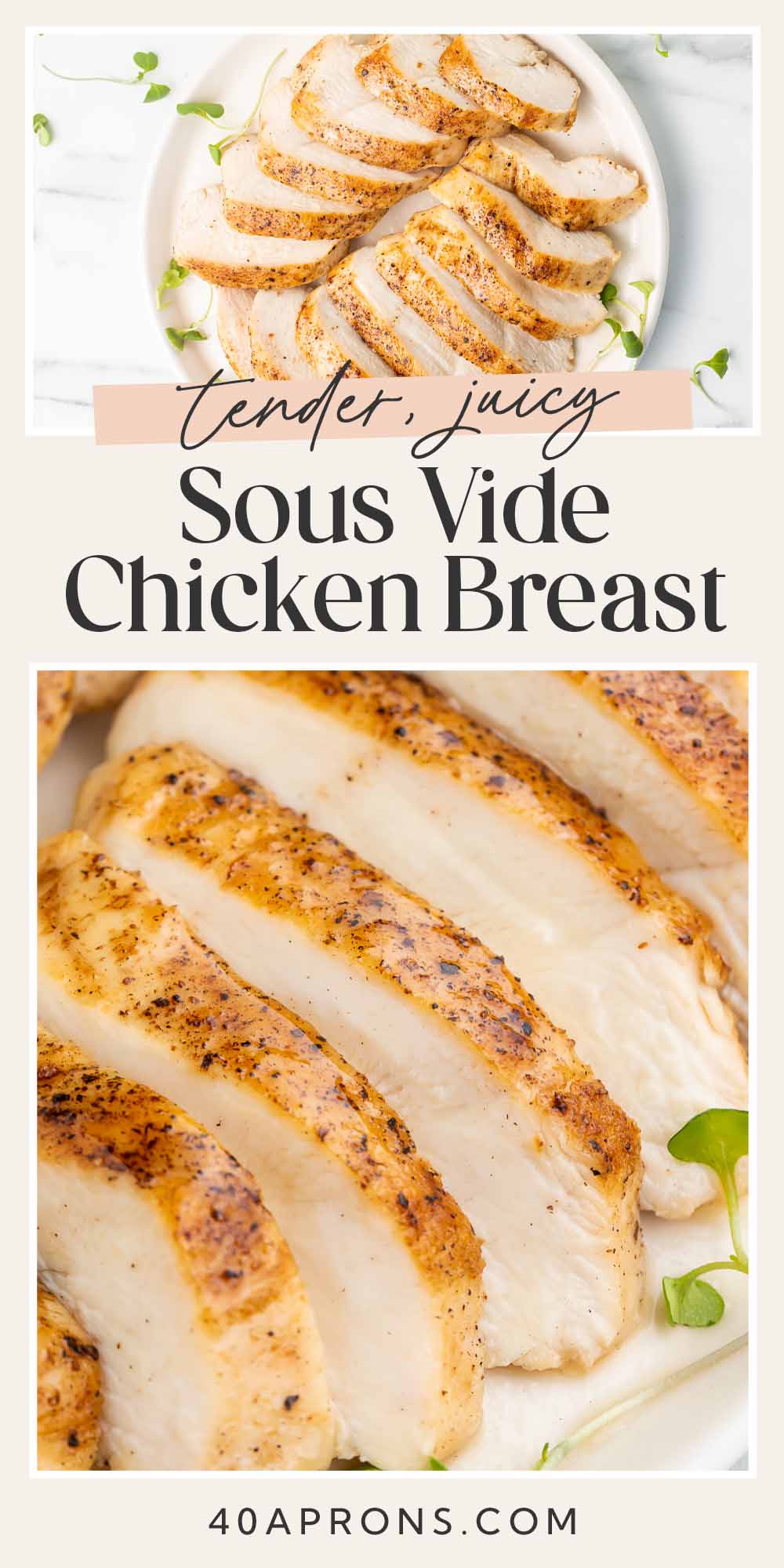
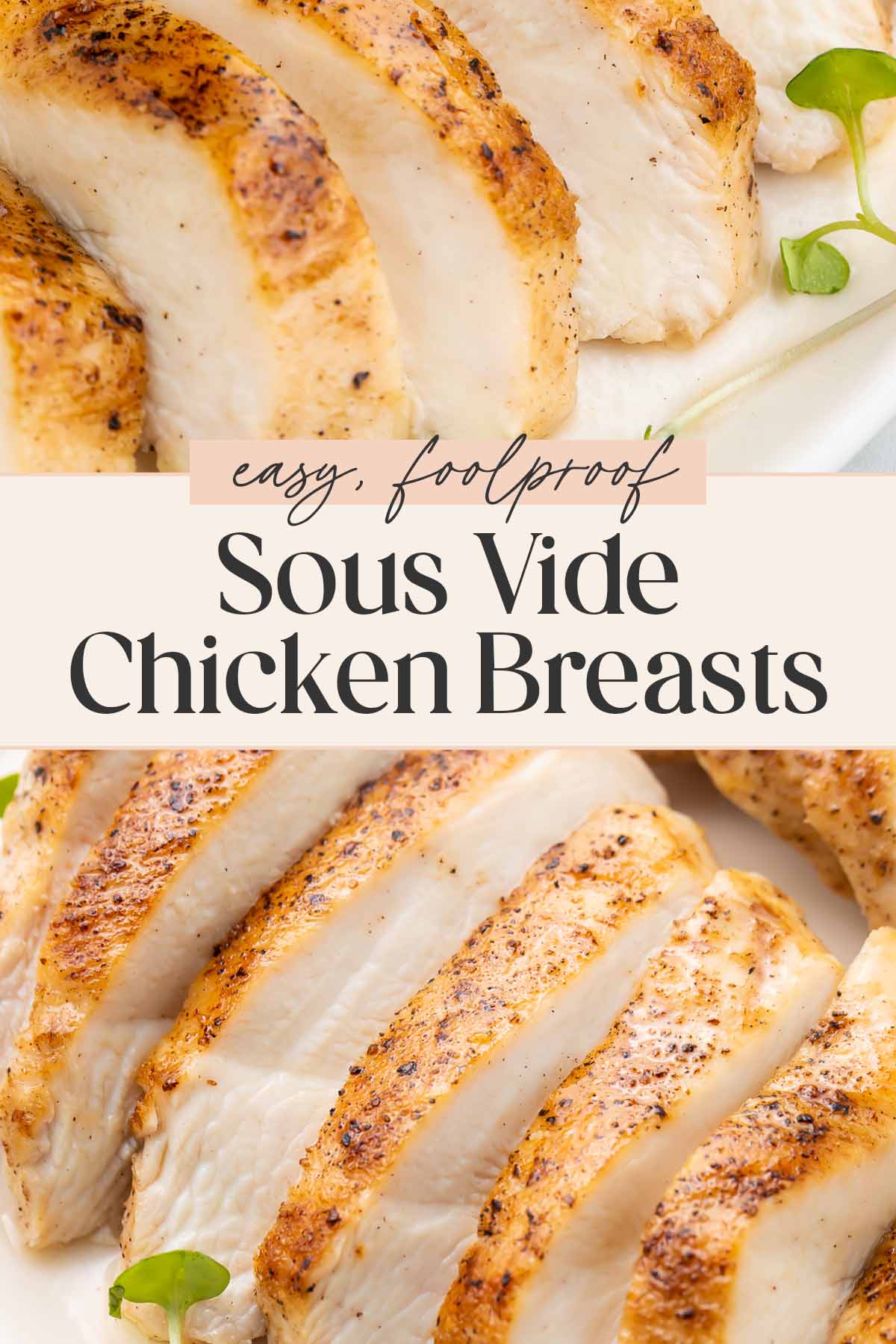


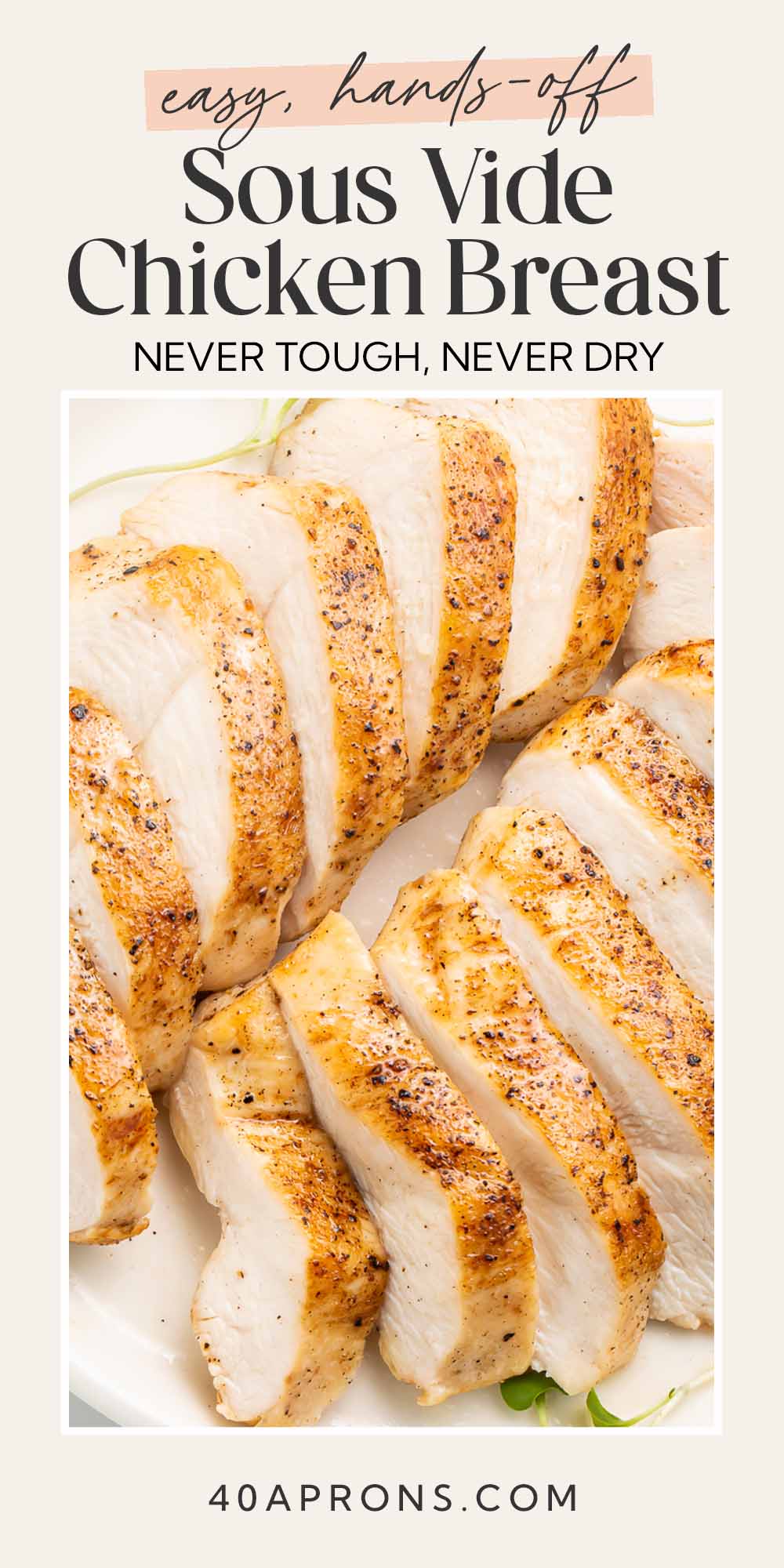
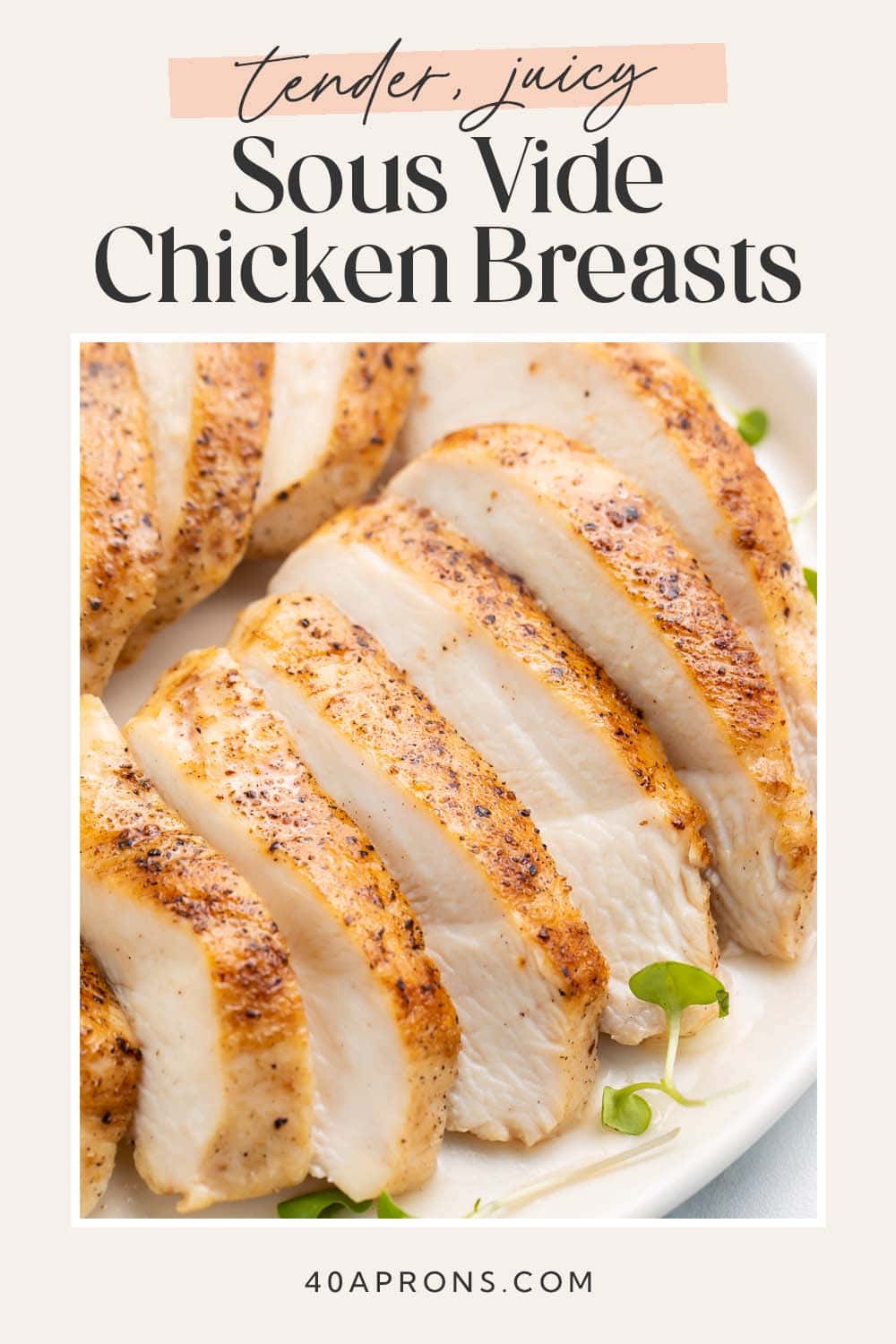

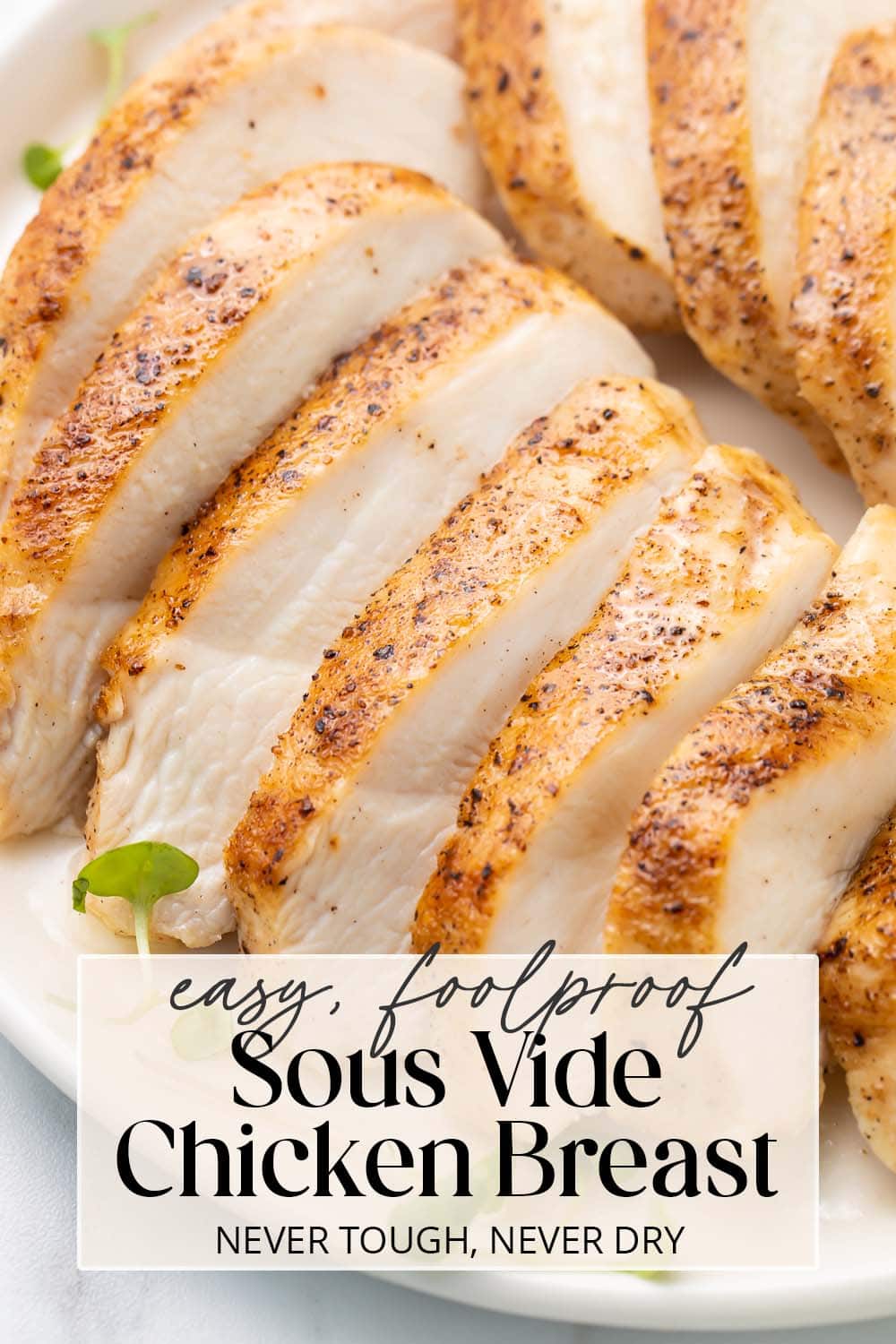


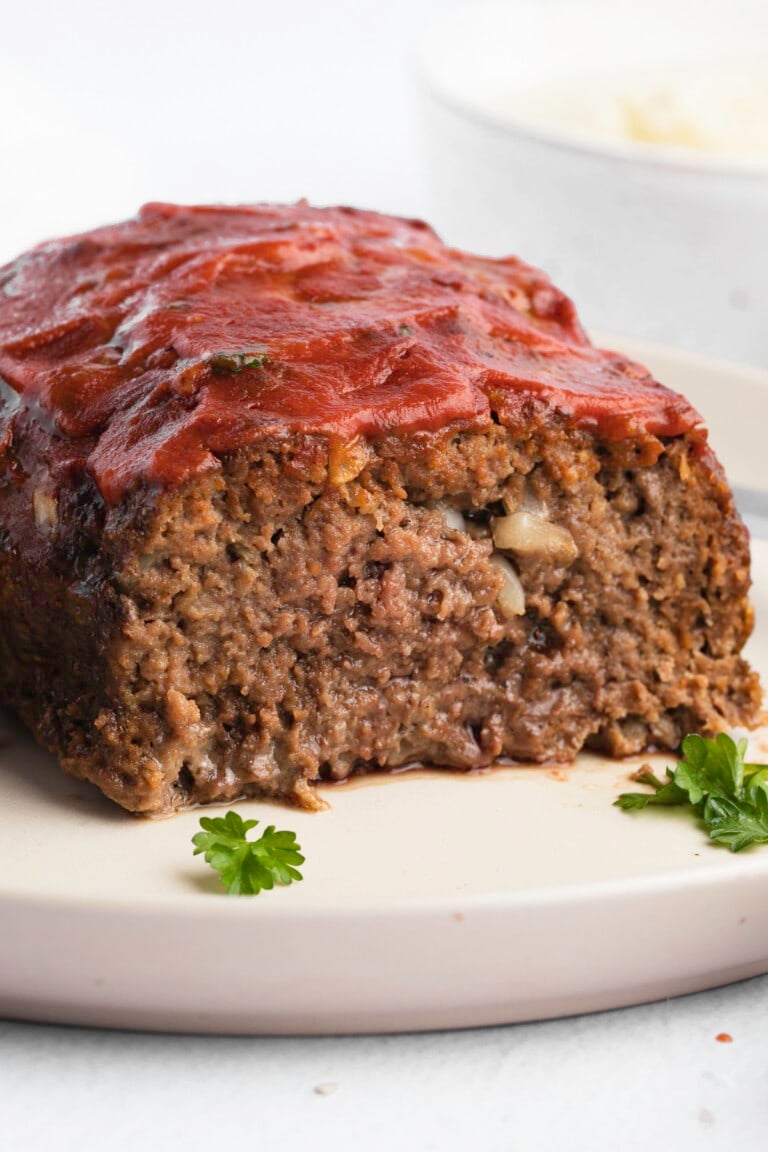













Incredible taste and quite juicy. I will only be cooking my chicken breasts with this method from now on! Thanks!
So happy you loved it, Pam! Thank you for leaving a review!
I made this today…DELICIOUS!! Thank you so much.
So glad you enjoyed it! Thanks for sharing. 🙂
If you double the recipe do you increase the cooking time? How important is it to have it completely submersed?
It’s critical that it’s completely submersed in the water to ensure everything is cooked evenly. You shouldn’t have to double the cooking time, but to be safe you could cook the chicken for 75 minutes.
What is the purpose of the olive oil? Thank you.
For flavor and to keep them from sticking to the bag!
tried doing it for an hour and a bit, but chicken was very chewy. not sure if it was not enough time?
You’ll need to cook for an hour in the sous vide, then finish it off in a skillet.
Loved this! My Sous-vide is in celsius, so I set to 64C rather than 63C to err on the side of caution. I found them a little dry. Ihad 3 breasts and put them in separate bags – this might have impacted it as well. would you suggest putting them all in one bag? or cooking at 63c instead of 64C? or both?
Delicious! will definitely do this again!
We would definitely recommend cooking at 63C rather than 64C and bagging all of them together so their juices can marinate all of the chicken breasts. Hope this helps!
Hi Cheryl! Can’t wait to try this recipe tonight.
When cooking sous vide, is it best practice to bring the meat to room temperature before cooking (i.e. thaw in the refrigerator, then bring it out to sit in room temp.)?
What about pre-heating the water? Some says “nah…just set it and forget it.”
Thanks!
I have tried both ways! Either way works.
We recommend preheating the sous vide cooker to 146.5°F.
Are you using your Sous Vide often on your cooking? and if yes, what are the most common ways or food that you use it for? I am trying to understand if Sous Vide cooking is something that can make the daily routine cooking much faster and easier or if is something correlated only to professional chef or kitchen. I have found this article of a professional Chef about sous vide pork tenderloin https://www.thefoodwonder.com/sous-vide-pork-tenderloin/ and i started to be very interested about this style of coooking. By the way.. i love your writing style, very engaging, would love to learn your skills. Do you sell any course or book?
We actually have a food blogging bootcamp about to start up! One more spot left!
Thanks for the recipe! Question, I thought chicken has to be cooked to 165 degrees F to be safe. How come I only set the temperature to 146.5?
The long bath actually pasteurizes the chicken, so even though it hasn’t reached 165, if kept at 146 for long enough, it will achieve the same effect of killing any microorganisms or bacteria.
At the end you will cook in a pan for a minute on each side. This will also help in getting the chicken to the proper temp.
This recipe looks delightful – but I should forewarn you… when it comes up as a recipe result on Google it lists dog in the ingredients. I’m thinking the wine pairing? But for real, do a search for “Easy Sous Vide Chicken Breast Recipe” and it lists sous vide, pinot noir, dog, skinless chicken breasts, butter. I’m glad to find out it’s not really dog, phew! ha ha!